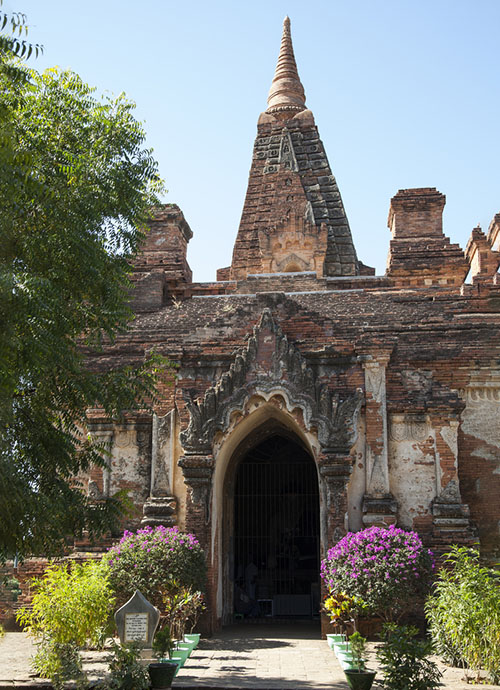
Gubyaukgyi
Indian influenced early 12th century “cave temple”
Northeast of old Bagan
The Gubyaukgyi temple near Wetkyi-in village Northeast of old Bagan was built by King Kyanzittha in the early 12th century. During his reign the empire saw prosperity and the construction of grand temples like the Ananda and the Myazedi pagoda.
Indian influence
The Gubyaukgyi’s architecture shows Indian influence, particularly the spire which resembles that of another temple in Bagan, the Mahabodhi. Both are based on the Mahabodhi temple of Bodh Gaya in India, the place where the Buddha reached enlightenment some 2,500 years ago.
The Gubyaukgyi is a cave temple; the first syllable of the temple’s name (“gu”) translates to “cave”.
Murals depicting Jataka tales
The interior walls and ceilings are decorated with fragments of ancient mural paintings that depict scenes from the Jataka tales, the stories that tell about the previous lives of the Buddha.
Exterior of the temple
The temple is oriented towards the East, where an antechamber containing the entrance protrudes from the structure. On the other three sides are false entrances in which large stone perforated windows are fitted. The exterior walls were plastered with stucco. Some of the fine stucco decoration is still intact, especially on the Eastern wall and the main entrance porch. The Gubyaukgyi temple is topped with a spire.
Unlike those of most temples and pagodas in Bagan its design is not bell shaped or cylindrical; its four sides are straight and diminishing in size towards the top.
Interior of the Gubyaukgyi
The temple’s interior is lit by daylight that comes in through large perforated stone windows. The first room from the Eastern entrance contains a large Buddha image seated on a high pedestal. The brick, plastered image is in the “Calling the Earth to witness” posture. The wall behind the image and the ceiling above contain well preserved murals with Buddhist depictions. The other rooms contain smaller images of the Buddha.
Murals depicting 28 Buddhas
On the North and South wall of the Gubyaukgyi are murals depicting the 28 Buddhas mentioned in the Tripitaka, the ancient Buddhist manuscripts that contain the teachings of the Buddha.
Photography inside the temple is not allowed, as the flash light would damage the ancient murals.
Getting to the temple
Other temples in Bagan
Among the other temples & pagodas in Bagan are:
- Shwezigon pagoda
- Ananda pagoda
- Gawdawpalin temple
- Sulamani temple
- Thatbyinnyu temple
- Seinnyet sister temples
- Bupaya pagoda
- Mahabodhi temple
- Htilominlo temple
- Mingalazedi pagoda
- Dhammayazika pagoda
- Dhammayangyi temple
- Lawkananda pagoda
- Manuha temple
- Pyathadar temple
- Pahtothamya temple
- Myazedi pagoda
- Shwesandaw pagoda
History
How to get to Bagan and how to get around
- Shwezigon pagoda
- Ananda pagoda
- Gawdawpalin temple
- Sulamani temple
- Thatbyinnyu temple
- Seinnyet sister temples
- Bupaya pagoda
- Mahabodhi temple
- Htilominlo temple
- Mingalazedi pagoda
- Dhammayazika pagoda
- Dhammayangyi temple
- Lawkananda pagoda
- Manuha temple
- Pyathadar temple
- Pahtothamya temple
- Myazedi pagoda
- Shwesandaw pagoda
- Gubyaukgyi temple